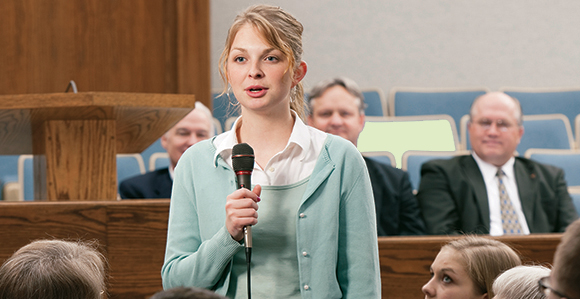
What have you missed most from your Sunday meetings since COVID-19 began in February? Our family would have to say testimony meetings. Do you know the evolution of testimony meetings and why this meeting is so important in our church? Read on ….
This week’s General Conference Odyssey covers the October 1988 Sunday afternoon session where the prophet at the time, Ezra Taft Benson, closed the conference with a powerful testimony. In his address, he simply states “pure testimony and witness to that which I know to be true.”
Upon reading this, I began thinking about my own testimony. How pure is it? Can I bear witness? Do I know what is true?
Glen Leonard, former director of the Museum of Church History and Art, explains the history of testimony meetings in the church. Fasting combined with prayer became a part of Israelite worship after the Hebrews fled Egypt. Testimony bearing followed as a verbal outpouring of their prayers. Many Christian faiths, in our day, follow this tradition.
As our church began to build up line upon line, it hit a significant moment when the Kirtland Temple was dedicated. People came to this grand and great meeting fasting and singing. Angels attended, as well as many of the great prophets of the Old Testament. Even the Savior was there. And testimonies were born during that spiritual feast.
Monthly fast meetings were originally held on the first Thursday of every month. This eventually became difficult as it disrupted work schedules. So, on 6 December 1896 fast meetings were officially changed to the first Sunday of every month. “Activities that had become part of the fast meeting continued: administering the sacrament, bearing testimonies, blessing children, confirming new members, and relieving the needs of the poor and ill” (Messages of the First Presidency of The Church of Jesus Christ of Latter-day Saints).
In 2013, the First Presidency came out with an official letter stating some instruction for testimony meetings. They expressed concern that time in Sacrament meeting needs to be guarded carefully so everyone desiring to bear their testimonies has time to do so.
This has been formally added in Handbook 2 (29.2.3) where families are encouraged to allow their children to bear testimonies at home, rather than during precious Sacrament meeting time.
Our family has always had a family testimony meeting on Fast Sunday at home. We borrowed this idea from my husband’s aunt and uncle when our kids were small. We all learned a lot of things as a result. We learned how to bear a pure (concise) testimony (kids don’t stay still forever), control nervousness, speak of spiritual things, and share thoughts and feelings in a safe place. After each testimony, the bearer walks around the room giving a hug to each family member. With six kids and two parents this was a time consuming task that brought great blessings to our family.
While searching for the references I’ve used in this post, I ran across a message from Pres. Spencer W. Kimball in the New Era that gives great instruction on testimony bearing. He explains that testimony comes from direct revelation, not from knowledge from the scriptures.
That revelation will be a testimony, a knowledge that Christ lives, that Jesus Christ is the Redeemer of this world. Every soul may have this assurance, and when he gets this testimony, it will have come from God and not from study alone. Study is an important element, of course, but there must be associated with study much prayer and reaching, and then this revelation comes.
During our meetings, we try to say something different from one another to make our testimonies more interesting. But really truth is very simple and true revelation reveals the same thing to all of us. How would it be to have 25-30 people stand up and say the same thing over and over again: “I know that Joseph Smith was called of God, a divine representative. I know that Jesus is the Christ, the Son of the living God.” The power that comes from those words—in testimony—can be spiritually edifying like nothing else can.
Pres. Kimball continues,
A testimony is not an exhortation; a testimony is not a sermon (none of you are there to exhort the rest); it is not a travelogue. You are there to bear your own witness. It is amazing what you can say in 60 seconds by way of testimony.
He encourages us to bear our testimonies often and overcome the fear. He says, “You have a testimony! It needs building and lifting and enlarging, of course; and that is what you are doing. Every time you bear your testimony it becomes strengthened.”
In this day and age, people are getting involved in causes that are taking them away from the church. It starts off small and innocent and before you know it you want nothing to do with the church. During COVID-19, testimony meetings have been canceled, temples have been closed, it’s been tough to worship as usual. But testimonies are born every time we open our mouths and declare truths of pure testimony.
Read Pres. Benson’s testimony. It’s pure. It’s straightforward. And it’s refreshingly true and full of power.